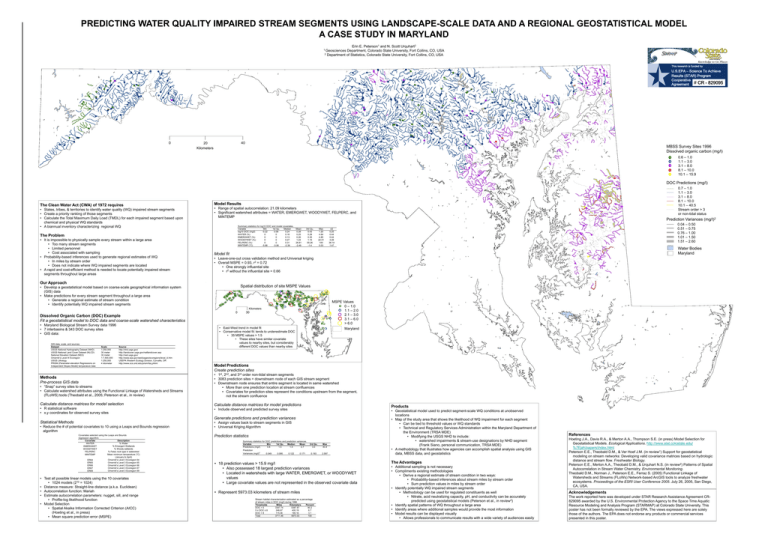Document 15307617
advertisement

PREDICTING WATER QUALITY IMPAIRED STREAM SEGMENTS USING LANDSCAPE-SCALE DATA AND A REGIONAL GEOSTATISTICAL MODEL A CASE STUDY IN MARYLAND Erin E. Peterson1 and N. Scott Urquhart2 1 Geosciences Department, Colorado State University, Fort Collins, CO, USA 2 Department of Statistics, Colorado State University, Fort Collins, CO, USA This research is funded by U.S.EPA – Science To Achieve Results (STAR) Program Cooperative Agreement # CR - 829095 0 40 20 Kilometers MBSS Survey Sites 1996 Dissolved organic carbon (mg/l) 0.6 – 1.0 1.1 – 3.0 3.1 – 8.0 8.1 – 10.0 10.1 – 15.9 DOC Predictions (mg/l) The Clean Water Act (CWA) of 1972 requires • States, tribes, & territories to identify water quality (WQ) impaired stream segments • Create a priority ranking of those segments • Calculate the Total Maximum Daily Load (TMDL) for each impaired segment based upon chemical and physical WQ standards • A biannual inventory characterizing regional WQ Model Results • Range of spatial autocorrelation: 21.09 kilometers • Significant watershed attributes = WATER, EMERGWET, WOODYWET, FELPERC, and MINTEMP Summary statistics for log10 DOC and model covariates. Variable Min 1st Qu. Median log10 DOC (mg/l) -0.22 0.08 0.24 WATER (%) 0 0 0.16 EMERGWET (%) 0 0 0.13 WOODYWET (%) 0 0 0.27 FELPERC (%) 0 0 0.31 MINTEMP (°C) -5.88 -3.06 -2.39 The Problem • It is impossible to physically sample every stream within a large area • Too many stream segments • Limited personnel • Cost associated with sampling • Probability-based inferences used to generate regional estimates of WQ • In miles by stream order • Does not indicate where WQ impaired segments are located • A rapid and cost-efficient method is needed to locate potentially impaired stream segments throughout large areas Mean 0.28 0.25 0.26 1.24 26.81 -2.49 3rd Qu. 0.43 0.28 0.35 1.15 55.26 -1.4 Max 1.20 4.64 4.85 22.01 100 0.03 Spatial distribution of site MSPE Values 0 MSPE Values 0 – 1.0 1.1 – 2.0 2.1 – 3.0 3.1 – 6.0 > 6.0 Maryland 30 Dissolved Organic Carbon (DOC) Example Fit a geostatistical model to DOC data and coarse-scale watershed characteristics Source http://nhd.usgs.gov/ http://landcover.usgs.gov/natllandcover.asp http://ned.usgs.gov/ http://www.epa.gov/wed/pages/ecoregions/level_iii.htm USEPA Western Ecology Division, Corvallis, OR http://www.ocs.orst.edu/prism/faq.phtml σ2 0.25 0.44 0.44 3.28 36.14 1.47 • Leave-one-out cross validation method and Universal kriging • Overall MSPE = 0.93, r2 = 0.72 • One strongly influential site • r2 without the influential site = 0.66 Kilometers Scale 1:250,000 30 meter 30 meter 1:7,500,000 1:250,000 4 kilometer • East-West trend in model fit • Conservative model fit: tends to underestimate DOC • 35 MSPE values > 1.5 • These sites have similar covariate values to nearby sites, but considerably different DOC values than nearby sites Model Predictions Create prediction sites • “Snap” survey sites to streams • Calculate watershed attributes using the Functional Linkage of Watersheds and Streams (FLoWS) tools (Theobald et al., 2005; Peterson et al., in review) • 1st, 2nd, and 3rd order non-tidal stream segments • 3083 prediction sites = downstream node of each GIS stream segment • Downstream node ensures that entire segment is located in same watershed • More than one prediction location at stream confluences • Covariates for prediction sites represent the conditions upstream from the segment, not the stream confluence Calculate distance matrices for model selection Calculate distance matrices for model predictions Methods Pre-process GIS data • R statistical software • x,y coordinates for observed survey sites Products • Include observed and predicted survey sites Generate predictions and prediction variances Statistical Methods • Reduce the # of potential covariates to 10 using a Leaps and Bounds regression algorithm Covariates selected using the Leaps and Bounds regression algorithm. Description Covariate % Water WATER % Emergent Wetlands EMERGWET % Woody wetlands WOODYWET % Felsic rock type in watershed FELPERC Mean minimum temperature (°C) MINTEMP (January to April) Omernik's Level 3 Ecoregion 64 ER64 Omernik's Level 3 Ecoregion 65 ER65 Omernik's Level 3 Ecoregion 66 ER66 Omernik's Level 3 Ecoregion 67 ER67 Omernik's Level 3 Ecoregion 69 ER69 • Test all possible linear models using the 10 covariates • 1024 models (210 = 1024) • Distance measure: Straight-line distance (a.k.a. Euclidean) • Autocorrelation function: Mariah • Estimate autocorrelation parameters: nugget, sill, and range • Profile-log likelihood function • Model Selection • Spatial Akaike Information Corrected Criterion (AICC) (Hoeting et al., in press) • Mean square prediction error (MSPE) 0.04 – 0.50 0.51 – 0.75 0.76 – 1.00 1.01 – 1.50 1.51 – 2.60 Model fit • Develop a geostatistical model based on coarse-scale geographical information system (GIS) data • Make predictions for every stream segment throughout a large area • Generate a regional estimate of stream condition • Identify potentially WQ impaired stream segments GIS data, scale, and sources. Dataset USGS National Hydrography Dataset (NHD) USGS National Land Cover Dataset (NLCD) National Elevation Dataset (NED) Omernik's Level III Ecoregion USGS Lithology PRISM (Parameter-elevation Regressions on Independent Slopes Model) temperature data Prediction Variances (mg/l)2 Water Bodies Maryland Our Approach • Maryland Biological Stream Survey data 1996 • 7 interbasins & 343 DOC survey sites • GIS data: 0.7 – 1.0 1.1 – 3.0 3.1 – 8.0 8.1 – 10.0 10.1 – 40.5 Stream order > 3 or non-tidal status • Assign values back to stream segments in GIS • Universal Kriging Algorithm Prediction statistics Summary statistics for DOC predictions and prediction variances. Variable Min 1st Qu. Median Mean Predictions (mg/l) 0.8 1.5 1.9 2.7 Prediction Variances (mg/l)2 0.049 0.095 0.122 0.171 3rd Qu. 3.0 Max 40.4 0.193 2.597 • 18 prediction values > 15.9 mg/l • Also possessed 18 largest prediction variances • Located in watersheds with large WATER, EMERGWET, or WOODYWET values • Large covariate values are not represented in the observed covariate data • Represent 5973.03 kilometers of stream miles Stream habitat characterization estimated as a percentage of stream miles in DOC (mg/l) during 1996. Thresholds Miles Kilometers Percent DOC < 5 3347.74 5387.67 90.2 5 ≤ DOC ≤ 8 248.67 400.19 6.7 DOC > 8 115.06 185.16 3.1 Total 3711.46 5973.03 100 • Geostatistical model used to predict segment-scale WQ conditions at unobserved locations • Map of the study area that shows the likelihood of WQ impairment for each segment • Can be tied to threshold values or WQ standards • Technical and Regulatory Services Administration within the Maryland Department of the Environment (TRSA MDE) • Modifying the USGS NHD to include: • watershed impairments & stream-use designations by NHD segment (Frank Siano, personal communication, TRSA MDE) • A methodology that illustrates how agencies can accomplish spatial analysis using GIS data, MBSS data, and geostatistics The Advantages • Additional sampling is not necessary • Compliments existing methodologies • Derive a regional estimate of stream condition in two ways: • Probability-based inferences about stream miles by stream order • Sum prediction values in miles by stream order • Identify potentially WQ impaired stream segments • Methodology can be used for regulated constituents as well • Nitrate, acid neutralizing capacity, pH, and conductivity can be accurately predicted using geostatistical models (Peterson et al., in review2) • Identify spatial patterns of WQ throughout a large area • Identify areas where additional samples would provide the most information • Model results can be displayed visually • Allows professionals to communicate results with a wide variety of audiences easily References Hoeting J.A., Davis R.A., & Merton A.A., Thompson S.E. (in press) Model Selection for Geostatistical Models. Ecological Applications. http://www.stat.colostate.edu/ %7Ejah/papers/index.html Peterson E.E., Theobald D.M., & Ver Hoef J.M. (in review1) Support for geostatistical modeling on stream networks: Developing valid covariance matrices based on hydrologic distance and stream flow. Freshwater Biology. Peterson E.E., Merton A.A., Theobald D.M., & Urquhart N.S. (in review2) Patterns of Spatial Autocorrelation in Stream Water Chemistry. Environmental Monitoring. Theobald D.M., Norman J., Peterson E.E., Ferraz S. (2005) Functional Linkage of Watersheds and Streams (FLoWs) Network-based ArcGIS tools to analyze freshwater ecosystems. Proceedings of the ESRI User Conference 2005. July 26, 2005, San Diego, CA, USA. Acknowledgements The work reported here was developed under STAR Research Assistance Agreement CR829095 awarded by the U.S. Environmental Protection Agency to the Space Time Aquatic Resource Modeling and Analysis Program (STARMAP) at Colorado State University. This poster has not been formally reviewed by the EPA. The views expressed here are solely those of the authors. The EPA does not endorse any products or commercial services presented in this poster.



